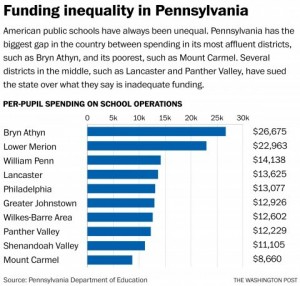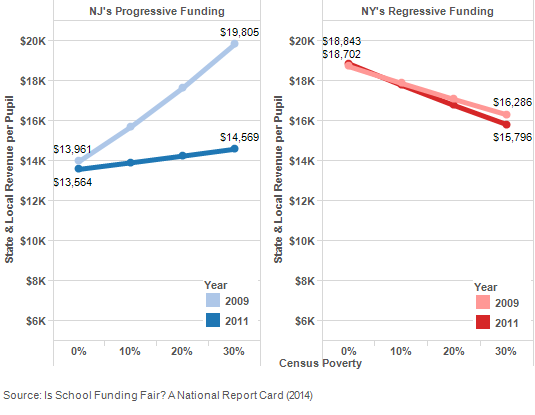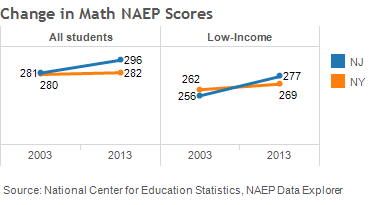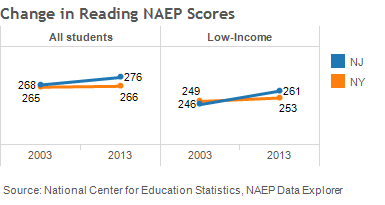Required reading:
- Bruce D. Baker, David G. Sciarra, and Danielle Farrie. Is School Funding Fair? A National Report Card. The Education Law Center publishes the nation’s most comprehensive state-by-state assessment of the degree to which schools are funded sufficiently and equitably, using four distinct metrics: funding level (per-pupil), funding distribution (degree to which funding is equitable relative to student poverty), effort (share of state GDP devoted to education), and coverage (proportion of students in public schools). The most recent full report (and executive summary) show that states have not restored funding to pre-recession levels, and that only a minority of states fund schools progressively – providing added funds for schools serving higher-poverty, and higher-needs, students.
- National Public Radio. Why America’s Schools Have a Money Problem. The debate over whether money matters in education is sufficiently big to capture the attention of NPR, which covered the issue in excellent detail in this recent series. Starting with a depiction of two tiny Illinois school districts that are just a few miles apart geographically but worlds apart in other ways – driven by a per-pupil disparity of $9,794 vs. over $28,000 – the series illustrates in stark detail the consequences for low-income students. Examples include small classes and experienced, well-paid teachers for wealthy students versus large classes with too few textbooks taught by novices in schools with broken toilets and no nurse or librarian for those with less money.
- Michael Rebell. 2009. Courts and Kids: Pursuing Educational Equity Through the State Courts. U of Chicago Press. (Chapters 1 and 2). Since there is no federal constitutional mandate for fair or sufficient public education, one response to this systemic inequity has been lawsuits brought by low-income districts in states across the country. Rebell, a Teachers College professor and one of the nation’s preeminent education equity litigators, presents the core historical issues around these lawsuits in the book’s first two chapters. (In recognition of the many cases that have been litigated, appealed, and decided since the book’s publication, Rebell prepared a supplement that provides an overview of developments since 2009. Up-to-date summaries of developments in adequacy cases in all 50 states are also available on the website of the National Access Network, schoolfunding.info.)
- Richard J. Murnane and Frank Levy “Evidence from Fifteen Schools in Austin, Texas” in Does Money Matter? Gary Burtless. 1996. While it seems intuitive that more money can help improve schools, there are studies finding otherwise and scholars who argue that more resources do not, in fact, improve education. This book, which grew out of a Brookings conference, brings together scholars from a variety of disciplines to discuss the evidence on the link between school resources and educational and economic outcomes. Murnane and Levy assert, based on evidence from AISD, that money does matter. Eric Hanushek is among the most prominent of those arguing the opposite, drawing scholarly critiques like this one.
Optional reading:
- Sarah Almy and Christina Theokas. 2010. Not Prepared for Class: High-Poverty Schools Continue to Have Fewer In-Field Teachers. One consequence of funding disparities is the challenges low-income schools face in trying to attract and retain the best teachers. Indeed, despite a provision in No Child Left Behind that every classroom have a highly qualified teacher by 2006, which was designed to ensure that low-income students and students of color had access similar to those of their higher-income peers to strong teachers, students in high-poverty schools are still twice as likely to be taught by out-of-field teachers (those without certification or a major in the core academic subject they are teaching) and disproportionately taught by rookies – teachers who are in their first year, and thus least effective at instruction.
- Noelle Ellerson and Elaine Weiss (2014). Rich Hill: The Gap between Student Needs and School Capacity. This white paper jointly produced by AASA and BBA as a companion to the documentary Rich Hill explores the unique challenges facing rural schools serving low-income students. In particular, it explains how nation-wide funding mismatches that afford fewer resources to high-needs schools are exacerbated in Rich Hill High School and others like it by their physical isolation and difficulty accessing the student and family supports that enable effective classroom teaching and learning.
- Campaign for Funding Equity, Alliance for Quality Education, Education Law Center, and the Public Policy and Education Fund of New York. January 2014. A Tale of Two States: Equity Outperforms Inequity. Taking advantage of natural variation in how these two high-spending states distribute their education dollars, the report makes a strong case for why equitable funding, in particular, affects student and school outcomes. As the authors state, “On opposite sides of the Hudson River, New York and New Jersey stand only a mile apart. But when it comes to how they fund their public schools, the yawning gulf between these two states is wide and deep. Unfair describes school funding in New York [while]. … [i]n sharp contrast, New Jersey school funding is fair. [And] The bottom line is that New York’s academic performance, as measured by high school graduation rates and test scores, trails New Jersey’s by wide margins.”
- Ognibene, Richard, Ed. A Persistent Reformer: Jonathan Kozol’s Work to Promote Equality in America. Peter Lang New York Teacher, journalist, and prominent education policy critic and activist, Jonathan Kozol has been calling attention to structural inequities in the US education system since 1967 when Death at an Early Age, his book about racism in Boston’s schools, was published and won a National Book Award. He has since written eleven more books that focus on segregation in schools and society, poverty, inequitable school funding, and many more. In this book, various scholars analyze Kozol’s perspective and proposed solutions with an eye toward their relevance today.
Graphics:

As reported by the Education Law Center in both its annual report card and a separate paper comparing two neighboring states, New Jersey’s per-pupil funding has been progressive in recent years — channeling more dollars to low-income students — while New York’s is the opposite:

One impact of this different between the two demographically similar and high-spending states can be seen in New Jersey’s much larger gains in NAEP scores in both reading and math during this time period, and its greater progress in closing achievement gaps between higher-income and lower-income students:


Video: In this December 2015 interview, Jonathan Kozol asserts that decades after he began to document the fact, “we still are running an apartheid education system [in which] funding for schools and resources for schools are savagely unequal.”
Book club: Jonathan Kozol, Savage Inequalities. 1991. Over two decades old, this vivid description of disparities between schools serving students of different races and social class unfortunately holds truer than ever. Based on Kozol’s observations of classrooms in public school systems in some of the nation’s poorest cities, he describes what takes place in both the lowest- and highest per-capita spending schools, ranging from just over $3,000 in Camden, New Jersey to $15,000 in Great Neck on Long Island. The book illustrates the overcrowding, unsanitary conditions, understaffing, and lack of such basics as textbooks, despite high tax rates levied on poor, minority communities to try to compensate for low tax bases. The book touches on both successful and unsuccessful lawsuits waged by plaintiffs in these poor districts and calls for an end to the racial segregation that he argues is alive and well in the American educational system.
Study Questions:
- Why do Americans tolerate, accept, and even defend a system that produces such a sharp mismatch between schools’ (and students’) needs and their abilities to meet them? What do you think it would take to affect a shift in that attitude?
- While overall, there is a close correlation between funding level and student achievement, that is not the only factor, and there are several major exceptions/outliers. For example, Washington, DC (DCPS) has one of the highest per-pupil funding levels in the country, but also one of the lowest levels of achievement and the largest race-based gaps, whether measured by NAEP scores, high school graduation rates, or others. How do these exceptions to the rule affect the debate around this issue? What do you think accounts for them?
- If you were to design a system for funding American schools from scratch, what would your priorities be, taking into account our preference for a high degree of local control, the reality of state and federal political priorities, etc.? (or, to what extent would you be willing to bypass those? What changes do you anticipate this new system might bring about?